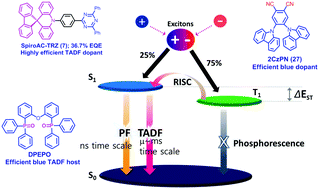Thermally activated delayed fluorescence blue dopants and hosts: from the design strategy to organic light-emitting diode applications
Abstract
Thermally activated delayed fluorescence (TADF) materials have attracted much attention in the field of organic light-emitting diodes (OLEDs), with their state-of-the-art performance in terms of external quantum efficiencies (EQEs), turn-on voltages, and color coordinates. TADF materials exhibited EQEs above 25% due to harvesting both singlet and triplet excitons via reverse intersystem crossing (RISC). A small singlet–triplet energy gap (ΔEST) is essential for TADF materials to exhibit efficient upconversion from the lowest triplet excited state (T1) to the lowest singlet excited state (S1, T1 → S1). Moreover, these materials are purely organic and thus not costly. Therefore, the TADF approach provides the best alternative to conventional fluorescent and phosphorescent OLEDs, regarding device efficiency and cost. On the other hand, blue light-emitting devices are facing several issues related to their stability and efficiency, making their development quite challenging for researchers. Herein, we review the recent advances in the use of blue TADF dopants and hosts in OLEDs.


 Please wait while we load your content...
Please wait while we load your content...